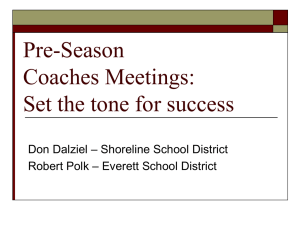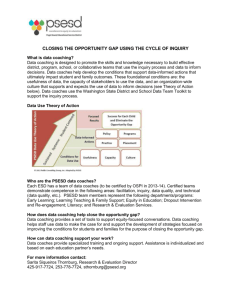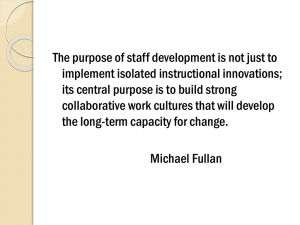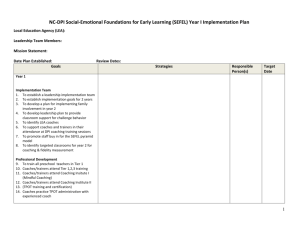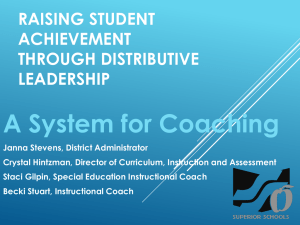Instructional Coaching: 7 Success Factors for Programs
advertisement
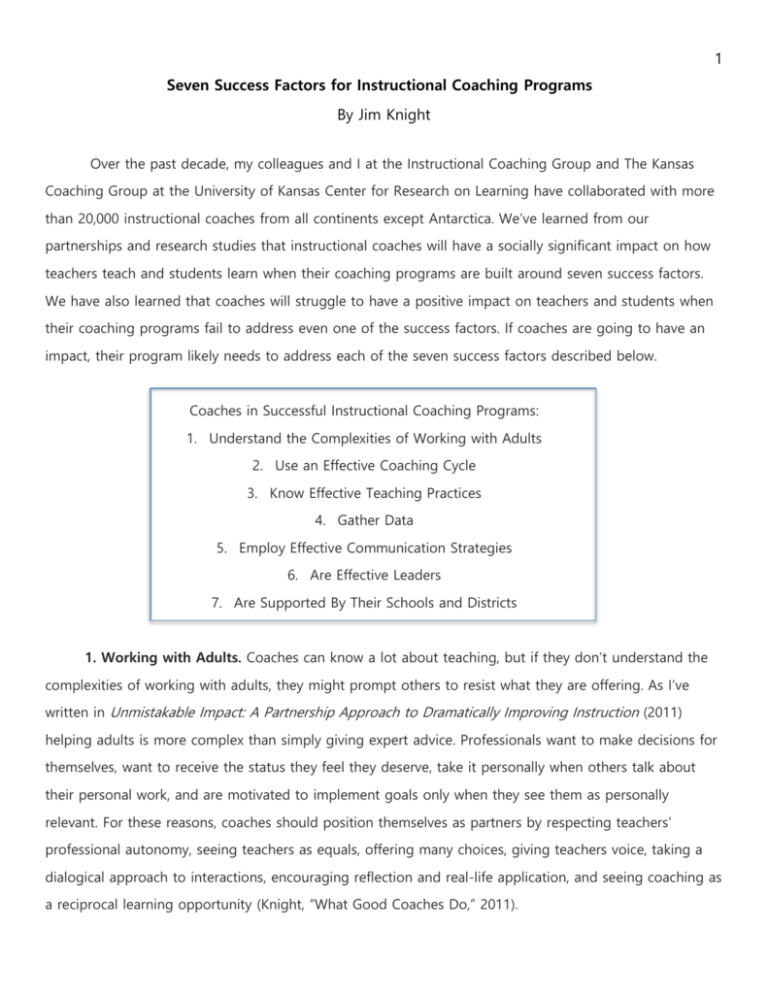
1 Seven Success Factors for Instructional Coaching Programs By Jim Knight Over the past decade, my colleagues and I at the Instructional Coaching Group and The Kansas Coaching Group at the University of Kansas Center for Research on Learning have collaborated with more than 20,000 instructional coaches from all continents except Antarctica. We’ve learned from our partnerships and research studies that instructional coaches will have a socially significant impact on how teachers teach and students learn when their coaching programs are built around seven success factors. We have also learned that coaches will struggle to have a positive impact on teachers and students when their coaching programs fail to address even one of the success factors. If coaches are going to have an impact, their program likely needs to address each of the seven success factors described below. Coaches in Successful Instructional Coaching Programs: 1. Understand the Complexities of Working with Adults 2. Use an Effective Coaching Cycle 3. Know Effective Teaching Practices 4. Gather Data 5. Employ Effective Communication Strategies 6. Are Effective Leaders 7. Are Supported By Their Schools and Districts 1. Working with Adults. Coaches can know a lot about teaching, but if they don’t understand the complexities of working with adults, they might prompt others to resist what they are offering. As I’ve written in Unmistakable Impact: A Partnership Approach to Dramatically Improving Instruction (2011) helping adults is more complex than simply giving expert advice. Professionals want to make decisions for themselves, want to receive the status they feel they deserve, take it personally when others talk about their personal work, and are motivated to implement goals only when they see them as personally relevant. For these reasons, coaches should position themselves as partners by respecting teachers’ professional autonomy, seeing teachers as equals, offering many choices, giving teachers voice, taking a dialogical approach to interactions, encouraging reflection and real-life application, and seeing coaching as a reciprocal learning opportunity (Knight, “What Good Coaches Do,” 2011). 2 The Partnership Principles 1. Equality 2. Choice 3. Voice 4. Dialogue 5. Reflection 6. Praxis 7. Reciprocity 2. Coaching Cycle. If teachers are to be positioned as professionals, they need to have a lot of autonomy, but coaching also must be accountable. Within coaching, we see accountability as coaches and teachers getting a clear picture of reality, setting powerful, student focused goals, and then collaborating until those goals are met. Effective coaching is more than a few conversations; good coaching leads to socially significant improvements in teaching and learning. Indeed, if student learning is not improving, instructional coaching isn’t working. For the past six years, my colleagues and I at the Kansas Coaching Project at The University of Kansas Center for Research on Learning have used design research to study and refine an instructional coaching cycle that honors teacher autonomy and is accountable. (Knight, Elford, Hock, Dunekack, Bradley, & Knight, in press). Working with coaches in Beaverton, Oregon and Othello, Washington, we developed and tested a three-stage instructional coaching cycle. The Instructional Coaching Cycle During the identify component of the instructional coaching cycle, coach and teacher get a clear picture of the current reality in the collaborating teacher’s classroom, often by video recording a class (Knight, 2014), looking at student work, reviewing assessment data, or some combination of these methods. Then 3 the coach guides the teacher to a student-focused goal. Usually student-focused goals deal with student achievement (for example, 90% of students get 5 out of 5 on a paragraph writing rubric 3 times in a row), behavior (for example, on average students are on task 95% of the time), or attitude (for example, 90% of students read for pleasure as measured by students’ journal comments). Once a goal has been set, teacher and coach identify a teaching strategy to be implemented in an attempt to hit the goal. During the learn component of the instructional coaching cycle, the teacher learns the teaching strategy with the help of the coach. Often instructional coaches describe teaching practices through the use of checklists, and then suggest various ways the teacher can see the practice in action. For example, a coach might model the practice in the teacher’s classroom, the teacher might visit another teachers’ classroom where the strategy is being used, the teacher might watch a video or see the practice in some other way. Once the teacher has learned the practice, it’s time to try it out. During the improve component of the instructional coaching cycle, the teacher tries out the new strategy in the classroom. Often the coach video records the lesson and gathers data on students’ progress toward the goal. Teacher and coach make adjustments as necessary, sometimes even choosing another teaching strategy, until the goal is met. 3. Teaching Practices. Instructional coaches help teachers improve student learning by improving teaching, so ICs need a deep knowledge of a set of strategies that they know will help teachers hit their goals. We refer to this as the Instructional Playbook. Strategies included in the Instructional Playbook might come from my book High-Impact Instruction (2013), Robert Marzano’s Art and Science of Teaching, John Saphire’s The Skillful Teacher (2008) or other publications focused on particular teaching strategies. What counts, though, is that the strategies described in the Playbook all are proven to help teachers meet their goals. An Instructional Playbook usually includes a one-page document that lists the teaching strategies teachers most frequently use, and checklists that describe the various elements of each instructional strategy. Thus, for example, a coach’s Playbook that includes cooperative learning might contain a checklist that describes some general guidelines for implementing cooperative learning, another that describes a specific cooperative learning structure such as Jigsaw, and a third that describes what students should do when they are participating in the learning structure. An effective Instructional Playbook is (a) comprehensive, addressing planning, assessment, instruction, and community building, (b) focused, including a small number of powerful strategies (ideally described on a single page) and (c) precise, containing a complete set of checklists for all of the included teaching strategies. 4 4. Gather Data. Coaches guide teachers to set and achieve goals, so it is essential they know how to gather basic observational data that can be used to set goals and monitor progress. Not all goals require observation. For example, if a teacher has set an achievement goal based on results on formative assessment, they may just need to review the assessments. However, frequently goals do involve coaches observing a class, gathering data, and sharing the data with teachers. Some of the most important data that coaches can gather include time on task (the percentage of students who are doing the learning task that the teacher has assigned); instructional versus noninstructional time; the type, kind and level of question asked; and ratio of interaction (a comparison of how often teachers attend to students when they are on task and learning compared with how often teachers attend to students who are off-task or disruptive). 5. Communication Skills. Coaching is relational, and coaches need to know how to build healthy relationships. Teachers rarely learn from collaborating coaches unless they see them as people they can trust. Since teaching is so connected to personal identity, coaches need to be especially adept at a few critical communication issues. Good communicators know that speaking the truth is only half the battle; the challenge is to speak the truth in such a way that it can be heard. We have found that coaches are more effective when they have particular communication skills and habits. Effective coaches usually are good listeners, ask good questions, build emotional connections, find common ground, build trust, and redirect destructive interactions. 6. Leadership Skills. In additional to communication skills, coaches need to have leadership skills. While leadership certainly involves communication, we have found that the coaches who lead change successfully have two additional attributes. First, they must be deeply respectful and responsive to the teachers with whom they collaborate, adjusting their approach depending on the personality and needs of each teacher and his/her students. Second, they must be assertive and disciplined, leading change in an organized, ambitious forceful manner. Both are necessary. Coaches who are responsive to teachers but undisciplined will waste teachers’ time and often lose sight of the end goal before the coaching cycle is complete. Coaches who are ambitious and disciplined, but not responsive, often push teachers away. The most effective coaches, as Jim Collins found when he studied effective leaders in great organizations, “are a study in duality: modest and willful, humble and fearless” (Collins, 2001, p. 22). 7. System Support. Instructional coaches that make an impact work in districts that create the conditions that help them be effective. In part this means that there is district-wide agreement about the 5 coaches’ roles (which often means that coaching is understood as a non-administrative role), what information is and is not confidential, a shared understanding of how coaches will relate to teachers (we suggest the partnership approach) and agreement on how coaches will use their time. Principals play an incredibly important role in shaping the success or failure of coaches. The most effective principals are instructional leaders who understand the positive impact professional learning can have on student learning. Principals who support coaches walk the talk by leading professional development sessions and agreeing to be coached themselves, perhaps by video recording model lessons and being coached during a staff meeting. Most importantly, principals that support coaches understand the power of coaching and communicate that frequently. If a principal does not speak out about the value of coaching, something needs to be changed or a coach will struggle to succeed. When it comes to instructional coaching, little changes can have a big impact. Teaching expectations, using rubrics, increasing positive attention, and using checks for understanding are just a few of the ways teachers working with coaches can dramatically increase student learning. When teachers learn, students learn. Such powerful positive changes won’t happen, though, if coaching programs are thrown together carelessly. Effective coaching programs provide professional development that ensure that the seven success factors described here are in place. When those factors are addressed, truly positive improvements can happen quickly and frequently. 6 References Collins, J. (2001). Good to Great: Why some companies make the leap and others don’t. New York, NY: HarperCollins Publishers. Freire, P. (1970). Pedagogy of the oppressed. New York, NY: Continuum. Knight, J. (2009). Instructional coaching. In J. Knight, Editor, Coaching: Approaches and Perspectives (pp. 29-55). Thousand Oaks, CA: Corwin. Knight, J. (2011). Unmistakable impact: A partnership approach for dramatically improving instruction. Thousand Oaks, CA: Corwin. Knight, J. (2011). What good coaches do. Educational Leadership. 69(2).18-22. Knight, J. (2013). High Impact Instruction: A framework for great teaching. Thousand Oaks, CA: Corwin. Knight, J. (2014). Focus on teaching: Using video for high-impact instruction. Thousand Oaks, CA: Corwin. Knight, J., Elford, M., Hock, M., Dunekack, D., Bradley, B.A. (in press). The instructional coaching cycle: Essential skills for instructional coaches. Journal of Staff Development. Lemov, D. (2010). Teach like a champion: 49 techniques that put students on the path to college. San Francisco, CA: Jossey-Bass. Marzano, R. J. (2007). The art and science of teaching: A comprehensive framework for effective instruction. Alexandria, VA: Association for Supervision and Curriculum Development. Saphier, J., Haley-Speca, M.A., & Gower, R. (2008). The skillful teacher: Building your teaching skills (6th ed.). Research for Better Teaching: Acton, MA.

